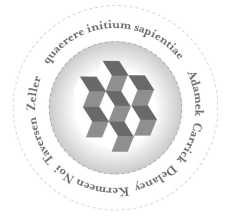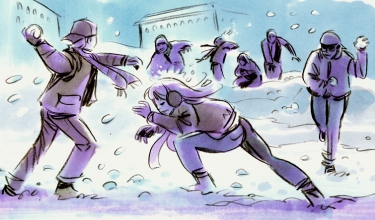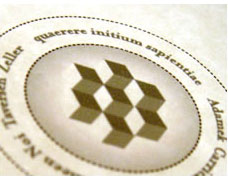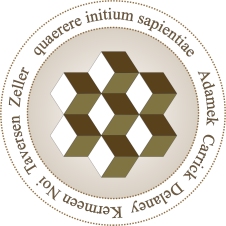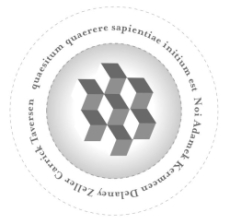Perplex City Academy
Master: Sente Kiteway
Website: http://www.perplexcityacademy.com
General
- The Academy is one of several Education facilities in Perplex City
- Students at The Academy are required to attend at least 2 years at some other place of learning prior to the Academy.
- After graduating from the Academy, students may also choose to take a Games Year.
Mission Statement
|
In years gone by, no organisation would have felt the need of a mission statement. In its place was the motto, the wise distillation of the aims and ethos of a school, a business or a family. Our motto still serves that function for us today. It means: To ask a question is the beginning of knowledge. This is our aim. We exist to ask new questions, to continue to investigate them. We believe that a playful, competitive spirit is the best way to access our most creative thinking. Our focus on puzzles leads us to see the value in unusual questions and unexpected answers. It is our mission not only to explore in the realms of knowledge but also to lead others to do so. Not only to shed light, but also to point out areas which need illumination by others. We are only a small body, but our effect can be far-reaching. This is our aim: always to question and always to seek the knowledge that comes from pursuing a puzzle. |
Departments
Departments within the Academy include:
The academy also runs Lunchtime Lectures/Evening Courses
History
A more complete history of the Academy can be found on the Academy website in the Visitors section. Much of what follows is paraphrased from there.
The Academy appears to be founded in around 1165 (573BC). Concrete evidence places it in existence by the year 1167 (571BC). The journal of Degabus of Malme explictly talks about a group of scholars whose goal it is to study "both the ancient and the modern mysteries." The scholars in question took up residence with a "Mrs Feon" of Kingdom Street, and quickly moved to the cellar of the estate of a "Mr Beston". This new location, in The Old Town, seems to be where the academy stayed, and grew out of. The famed Beston Rooms which are in use in the Modern Academy are probably not the same rooms used so long ago, but the location seems historically accurate.
During the next few years, the Academy remained in the Old Town. It started out having a somewhat shoddy reputation, but quickly grew in size, taking on additional rooms in the area of those original Beston cellars. At some point early on, The Academy began charging a tuition service to the sons and daughters of wealthy townsfolk as a way of funding its continuing research. No scholars of note were yet resident in the Academy, but the place was well remarked upon.
The Academy's first significant expansion came in 1286 (452BC), with a gift from Naskent Taversen, one of the City's wealthiest and most influential landowners. His only daughter, Aetiant Taversen, was at that time in attendance at the Academy, and apparently negotiated with her father the substantial gift he gave the institution. Naskent Taversen eventually gifted his house, along with various surrounding pieces of property, to the Academy in perpetuity, which led the Academy to substantial growth and stability. When, in 1295 (443BC), Aetiant Taversen was elected by the other fellows of the Academy to become its first 'Master', she was able to preside over an unprecedented period of growth and success in which, for the first time, the Academy was able to select its pupils.
After Aetiant Taversen's death, there was considerable debate as to who should be the next Master. factions were divided between Catherine Carrick who favoured a focus on puzzles, and Philosopher Boaz Delaney, who believed in learning first and foremost. After three years, the fellows finally agreed to elect Carrick and Delaney joint Masters. This had the effect of making both parties uneasy, and the division between puzzlers and higher learning rages through The Academy today.
Throughout the next century or so, The Academy -- and indeed Perplex City as a whole -- matured. It was during this time the Academy began forming departments (Cryptology being the first), and began requiring students attend an Other school of Education for at least 2 years before coming to The Academy. (This was, of course, frowned on by some.) In 1493 {245 BC), Helios Noi made considerable contributions to the Academy, including significant developments of the field of biological sciences.
In 1566 (172BC), The Accords of 172BC brought greater stability and a resurgence of interest in the arts and science. The Academy Museum was opened, and The Academy Library was opened to the public. This all came on the heels of the great depression of the early 1500s.
In the years approaching the year 1 AC, Many upstarts occurred. A breakaway group started The Conservatoire, which was probably a bad idea all around. This division, coupled with the poorly handled accounts which followed The Conservatoire's collapse, on top of a few flailing business ventures, caused a great disruption within The Academy. Much blame was placed on Master Cestmir Zafferin. After the death of Master Victor Mardian, it appeared to some as though The Academy might fold, entirely.
It was by some miracle then to have Vianne Adamek step in as the new, profoundly level headed Master. Adamek's accomplishments are numerous, most of which involve setting up grants and aids for Acadey students. The influence of Adamek's legacy stretched into the heart of Robart Kermeen, the great puzzle-setter who commented "one almost feels Adamek's mind still working within the Academy's walls". Kermeen forged strong ties with the Perplex City Academy Games, and instituted the first "summer school" for prospective Games participants, a tradition which continues to this day. Kermeen also oversaw the extensive building works which marked this period of the Academy's (and, indeed, the city's) history. It was Kermeen, too, who first put substantial resources into the field of Cube studies, a practice continued by the Masters who came after him through into the next century.
Most schoolchildren know the story of Hesketh Zeller, if not for the vast strides he made in the pursuit of Cube knowledge then at the very least for the circumstances surrounding his noble death. One of the few Masters to continue active research while holding the position, he was certainly the first to pay the ultimate price for his work in the dangerous area of Cube studies.
Senior Staff
Staff and student details can be found on the Characters#Perplex_City_Academy page. There are many.
- Sente Kiteway - Master of the Academy
- Henrik Tanner - Director of Security
- Patrick Azadian - Assistant to the Master
- Inari Ekeba - Senior Fellow: Natural Sciences
- Sanjean Adamek - Senior Fellow: Arts
- Astrid Lindstrom - Senior Fellow: Mathematics and Logic
- Bella Egremont - Senior Fellow: Mathematics and Logic
- Hunan Mansoor - Senior Fellow: Cryptology
- Margaret Wildwood - Senior Fellow: Social Sciences
- Estelle Sedgewick - Senior Fellow: Languages
Student Organisations
- There are more than 500 different clubs and societies, ranging from electronic gaming to earthology, from climbing to combat-sports.
- Perhaps the best known is the Perplex City Academy Games (PCAG).
Academy Building and Grounds
- The Academy's subway station, Taversen Square, is within easy reach of the Academy grounds.
- Academy Tours run twice daily from Gatehouse 12, which is located near to Polygon South Station
- The Academy has numerous gatehouses leading from Perplex City into the Acadmey
- Gatehouse 24 - Employee's entrance
- Gatehouse 12 - Vistor's entrance
- Places of interest include:
- Anaduna Corridors
- The Founder's Gallery
- Catacombs
- The Unsolved Qi-Qu Puzzle
- The Bell Tower
- The Clock of Marbles
- Taversen Square
- The Great Lawn
- Library
- The Bridge Restaurant
- Undercroft Communal Dining Halls
- Arboretum
- Senior Fellows Grounds
- Vasquez Observatory
- Adamek Green
- Academy Museum
- Great Gallery
- Cube Hall
- Mazy Wave Court
- Carrick Room
Academy Museum
The Academy Museum features regular exhibitions, especially those concerning the ancient history of Perplex City. The current exhibit features:
- The set of earthenware vessels now known as the Tronten Collection
- on exhibit for the first time since the micro-restoration work undertaken on them.
- The set of carved bone animals found during the construction of the Mobius Strip Development Site.
- The animals range from about 30mm to about 80mm tall
- Portrayed are some species no longer known in the area
- Several state-of-the-art learning aids
- Re-created walk through the area as it would have looked 3,000 years ago.
- Interact with our historically realistic AIs as they plan a deer hunt across the northern plains
- join modern-day archaeologists as they piece together the story of an encampment in the forest.
Of course, what could be the most important permanent exhibit at the Academy Museum is The Receda Cube.
Academy Logo
- The Academy's logo bears the latin phrase : quaerere initium sapientiae which has the rough translation, To ask a question is the beginning of knowledge, sounds intriguingly close to a Khalil Gibran quote : Perplexity is the beginning of knowledge. It also alludes to Joseph Dewey's "The asking of questions is the beginning of knowledge".
- A new logo that appeared in the Perplex City Sentinel on 18th April bears a new Latin phrase quaesitum quaerere sapientiae initium est. This translates to investigation to seek wisdom beginning is. Sounds very close to Clarence Darrow: Skepticism and doubt lead to study and investigation, and investigation is the beginning of wisdom. It may also refer to the apocryphal text The Wisdom of Solomon, 6:17: "The beginning of wisdom is the most sincere desire for instruction."
This logo was changed on the Perplex City Sentinel site on the 19th, and mentioned in the corrections page. It seems that the different logo was a mistake, but whether this was in game or out of game has yet to be determined.
